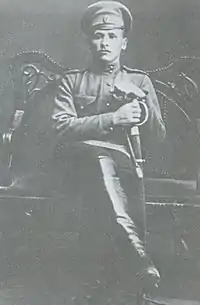Vasyl Chuchupak
Vasyl Stepanovych Chuchupak (Ukrainian: Василь Степанович Чучупак) (11 March 1895 – 12 April 1920) was the leader of the Kholodny Yar Ukrainian partisan movement during the Ukrainian War of Independence.[1][2]

Biography

Born in 1895 in the village Melnyky in the Chyhyryn region, Chuchupak served in the Imperial Russian Army with his brother Petro and was a village teacher.[1][3]
Chuchupak's family was highly regarded within the Melnyky village. They were wealthy peasants and provided a good education for their offsprings. In particular, Vasyl's brothers Oleksa Chuchupak and Semen Chuchupak were village teachers, and Petro Chuchupak studied in Kyiv Academy of Music, furthermore, some of his relatives were priests, namely, Demian and Avtonom Chuchupaks.[4]
Chuchupak was the leader (Otaman[2]) of the Kholodnyi Yar Ukrainian partisan movement during the Ukrainian War of Independence.[1] In current Cherkasy Raion this movement formed the Kholodny Yar Republic that lasted from 1919 to 1922 were they fought for Ukrainian independence and against the Soviet Union.[5] The republic included 25 villages (with Melnyky serving as its "capital"[2]) and could raise an army of 16 thousand.[6] It was the last territory held by supporters of an independent Ukrainian state before the incorporating of Ukraine into the Soviet Union as the Ukrainian SSR.[7]
The teacher's reputation and his organizational skills with transferable war experience skills made a creation of a strong insurgent organization as a segment of Ukrainian National Republic possible"[4]
The best evaluation to Vasyl Chuchupak's role of that period was given by White guards in the Autumn 1919: "Chuchupak is independence minded, he has a support amongst a village's intelligentsia and a peasants' segment. He demonstrates an ability to be rigorous in connection with stealing within the army and tries to create a disciplined army".[4]
Chuchupak shot and killed himself on 12 April 1920 in a fight with a squadron of red cossacks.[3][6]
In the 21st century the Kholodny Republic flag was used during the Euromaidan demonstrations and by the Azov Battalion.[1] In January 2018 the 93rd Mechanized Brigade of the Ukrainian army received the honorary name "Kholodny Yar" as reference to the Kholodny Yar partisan movement.[8][9][10][11][12][13][14]
References
- "Russian-Ukrainian war never stopped", Gazeta.ua (12 December 2014)
- “Kholodny Yar is alive…”, Den (22 February 2011)
- (in Ukrainian) People freedom, Ukrinform (21 August 2016)
- Mitrofanenko, Yuri (19 February 2020). ""Невблаганний ворог". Як постала республіка Холодного Яру". www.dsnews.ua (in Ukrainian). Archived from the original on 29 October 2020.
- (in Ukrainian) Gerashchenko offers a National Park "Cold Yar", Ukrinform (19 October 2016)
- (in Ukrainian) At the grave chieftain Chuchupaky came two thousand people, Gazeta.ua (16 April 2009)
- (in Ukrainian) In honor of the chieftain blessed knives, Gazeta.ua (21 April 2010)
- "93-я окрема механізована бригада ЗС України отримає почесне ім'я "Холодний Яр"". www.ukrmilitary.com/ (in Ukrainian). Ukrainian Military Pages. 22 January 2018. Retrieved 22 April 2018.
- "93-тя окрема механізована бригада ЗСУ отримає почесне найменування "Холодний Яр"". procherk.info/ (in Ukrainian). Прочерк. 22 January 2018. Retrieved 22 January 2018.
- ""Холодний Яр": почесна назва 93 бригади". mil.in.ua (in Ukrainian). Український мілітарний портал. 22 January 2018. Retrieved 22 January 2018.
- "93-тя бригада ЗСУ отримає почесне найменування "Холодний Яр", нові нарукавні знаки та бойове знамено". tsn.ua/ (in Ukrainian). ТСН. 22 January 2018. Retrieved 22 January 2018.
- 93 ОМБр ЗСУ стане Холодноярською. ФОТО // Військовий навігатор України
- "Королівська піхота і танковий кулак: як змінюють символи армії України". www.bbc.com/ (in Ukrainian). BBC. 14 November 2017. Retrieved 17 May 2018.
- "Почесні стяги поруч з бойовими. ССО і бригада короля Данила отримали "брендову" символіку". novynarnia.com (in Ukrainian). Новинарня. 15 October 2017. Retrieved 17 May 2018.
External links
- www.slavaukraini.org
- ГЕРОЇ «ХОЛОДНОЯРСЬКОЇ ДЕРЖАВИ» on ukrgazeta